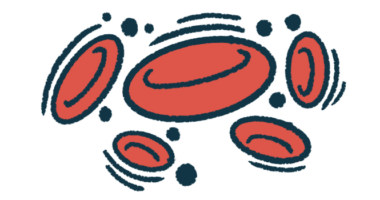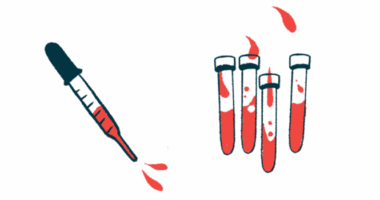PNH disease management in the Middle East similar to other regions
Review: Presenting symptoms consistent with that of outside populations

The management approach to paroxysmal nocturnal hemoglobinuria (PNH) in the Middle East is generally consistent with that reported in other regions, according to a review of published studies.
Across all studies from Saudi Arabia, Kuwait, Egypt, Oman, and Lebanon, anemia and fatigue were common presenting symptoms, with most patients benefiting from Soliris (eculizumab) as the main treatment.
“Additional data are required to gain greater insight into the status of PNH and its management in Middle Eastern populations,” researchers wrote.
The study, “Clinical characteristics and management of paroxysmal nocturnal hemoglobinuria in the Middle East: a narrative review,” was published in Clinical and Experimental Medicine. The study received financial support from Alexion, AstraZeneca Rare Disease, which markets Soliris.
PNH marked by destruction of blood cells
PNH is a rare acquired genetic disease marked by the destruction of blood cells, particularly red blood cells, by the abnormal activation of the complement system, a part of the immune system. Common symptoms include dark-colored urine, low blood cell counts, trouble swallowing, abdominal pain, and shortness of breath.
Launched in 2004, the International PNH Registry (NCT01374360) is an observational study conducted to understand PNH progression and the outcomes of treated and untreated patients.
“However, because not all countries participate in the International PNH Registry, little is known about the epidemiology and management of PNH in certain world regions,” wrote the researchers who reviewed published data on the incidence, characteristics, diagnosis, and treatment of PNH in Middle Eastern populations of Arabic origins.
From a database search, the team selected 15 studies from several countries, including Saudi Arabia, Iran, Kuwait, Egypt, Oman, and Lebanon. The reports included data on 26 children and 209 adults with PNH.
The mean age at diagnosis was 38 years, as a study from Iran reported. The average incidence of PNH was 1.9 new cases per 5 million people per year based on one study from Oman, “although no conclusions can be drawn based on the results of one study from a single country within the region,” the researchers wrote.
Many cases were diagnosed using flow cytometry, a test that measures the levels of certain molecules on the surface of blood cells, which are either low or undetectable in PNH. In a few cases (4%), patients with severe persistent low blood cell counts, or cytopenia, who underwent bone marrow evaluation were found to have PNH. Overall, PNH positivity rates ranged from 4% to 36% and varied by diagnostic approach and population.
Anemia, fatigue common symptoms in Middle Eastern PNH patients
Across studies from Saudi Arabia, Oman, and Iran, most PNH patients presented with anemia. Fatigue was also common. Some also had bone marrow syndromes, such as aplastic anemia, where bone marrow stops making enough new blood cells, or pancytopenia, a reduction in the number of red blood cells, white blood cells, and platelets.
“Common symptoms reported in Middle Eastern patients with PNH were anemia and fatigue, as also described in the International PNH Registry patient population,” the team wrote.
Clone sizes, or the proportion of blood cells carrying PNH-causing genetic mutations, ranged from less than 1% to more than 60%, with the largest clone sizes often seen in those ages 25 to 45.
Soliris was the main treatment used in Middle Eastern PNH patients to ease symptoms and prevent blood clotting, or thrombosis. However, some patients required ongoing blood transfusions and, in one case, a bone marrow transplant. The use of Ultomiris (ravulizumab-cwvz) in the Middle East remains undocumented, the team noted.
Studies from Iran and Oman reporting on the outcomes of patients who underwent a stem cell transplant showed the procedure carried significant risks of graft-versus-host disease, which happens when the healthy transplanted stem cells attack the recipient’s cells.
The available published information on PNH in the Middle East suggests that the disease presentation and management approach are generally consistent with that in populations outside the region.
A Saudi Arabian case series of 10 pregnancies in four women with PNH reported varied outcomes, including live births, miscarriages, fetal death, and one case of congenital anomalies with a family history. All patients received anticoagulation therapy, or blood thinners and transfusions as needed. Most were treated with Soliris, often at higher doses during pregnancy.
The researchers also reported on unusual presentations and coexisting medical conditions. A patient in Kuwait with the autoimmune disease lupus was diagnosed with PNH after developing low platelet counts and portal vein thrombosis, or blood clots in the liver’s central vein. In Saudi Arabia, a woman developed anemia, kidney injury, and bone marrow toxicity after using an herbal medicine. She was subsequently diagnosed with PNH. In Lebanon, a young woman developed pancytopenia following COVID-19 vaccination and was then diagnosed with PNH.
“The available published information on PNH in the Middle East suggests that the disease presentation and management approach are generally consistent with that in populations outside the region,” the researchers wrote.









